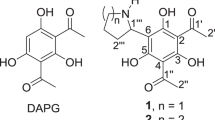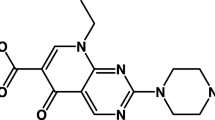Summary
The binding of radioactivity from14C-penicillin G labelled in the acyl side chain toProteus mirabilis D 52 was examined.
Under the conditions of the binding assay about 90% of the cells lost their viability upon saturation with radioactivity from14C-penicillin G which required 18 μg penicillin G/mg dry weight of cells and an incubation time of 2 h at 37° C.
Examination of 6-aminopenicillanic acid showed that this compound, in contrast to grampositive bacteria, has little effect on the binding of radioactivity from14C-penicillin G toP. mirabilis D 52. In contrast to 6-aminopenicillanic acid, inhibition of binding of radioactivity from14C-penicillin G toP. mirabilis D 52 is obtained with phenacetylglycine, a compound considered as structural analogue of the acyl side chain in penicillin G. In addition, this compound interferes with a basic property of penicillin G in that in its presence formation of sphaeroplasts is prevented. A reaction, specific for gramnegative bacteria, is proposed in which the acyl side chain of penicillin G is transfered to a cellular component.
Similar content being viewed by others
References
Araki, Y., Shimada, A., Ito, E.: Effect of penicillin on cell wall mucopeptide synthesis in anEscherichia coli particulate system. Biochem. biophys. Res. Commun.23, 518–525 (1966).
Clarke, H. T., Johnson, J. R., Robinson, R.: The chemistry of penicillin. Princeton: Princeton University Press 1949.
Cooper, P. D.: Site of action of radiopenicillin. Bact. Rev.20, 28–48 (1956).
Daniel, J. W., Johnson, M. J.: Properties of the penicillin binding component ofMicrococcus pyogenes. J. Bact.67, 321–328 (1954).
Edwards, J. R., Park, J. T.: Correlation between growth inhibition and the binding of various penicillins and cephalosporins toStaphylococcus aureus. J. Bact.99, 459–462 (1969).
Erlanger, B. F., Goode, L.: Mode of action of penicillin. Nature (Lond.)213, 183–184 (1967).
Ford, H. J.: A conveniant synthesis of phenaceturic acid. J. Amer. chem. Soc.71, 3842 (1949).
Izaki, K., Matsuhashi, M., Strominger, J. L.: Glycopeptide transpeptidase andd-alanine carboxypeptidase: penicillin-sensitive enzymatic reactions. Proc. nat. Acad. Sci. (Wash.)55, 656–663 (1966).
Kaufmann, W.: The possible implication of a bacterial enzyme in the biochemical mode of action of penicillins on gramnegative bacteria. Biochem. biophys. Res. Commun.14, 458–462 (1964).
Katz, W., Martin, H. H.: Peptide crosslinkage in cell wall murein ofProteus mirabilis and its penicillin-induced unstable L-Form. Biochem. biophys. Res. Commun.39, 744–749 (1970).
Lawrence, P. J., Strominger, J. L.: Biosynthesis of the peptidoglycan of bacterial cell walls. XV. The binding of radioactive penicillin to the particulate enzyme preparation ofBacillus subtilis and its reversal with hydroxylamine or thiols. J. biol. Chem.245, 3653–3659 (1970a).
——: Biosynthesis of the peptidoglycan of bacterial cell walls. XVI. The reversible fixation of radioactive penicillin G to thed-alanine carboxypeptidase ofBacillus subtilis. J. biol. Chem.245, 3660–3666 (1970b).
Maass, E. A., Johnson, M. J.: Penicillin uptake by bacterial cells. J. Bact.57, 415–422 (1949).
Pruess, D. L., Johnson, M. J.: Enzymatic deacylation of S35-benzylpenicillin. J. Bact.90, 380–383 (1965).
Rogers, H. J.: The inhibition of mucopeptide synthesis by benzylpenicillin in relation to irreversible fixation of the antibiotic by staphylococci. Biochem. J.103, 90–102 (1967).
Schepartz, S. A., Johnson, M. J.: The nature of binding of penicillin by bacterial cells. J. Bact.71, 84–90 (1956).
Schneider, C. H., de Weck, A. L.: A new chemical aspect of penicillin allergy: the direct reaction of penicillin with ε-amino-groups. Nature (Lond.)208, 57–59 (1965).
Schwarz, U., Asmus, A., Frank, H.: Autolytic enzymes and cell division ofEscherichia coli. J. molec. Biol.41, 419–429 (1969).
Strominger, J. L., Izaki, K., Matsuhashi, M., Tipper, D. J.: Peptidoglycan transpeptidase andd-alanine carboxypeptidase: penicillin-sensitive enzymatic reactions. Fed. Proc.26, 9–22 (1967).
Taubeneck, U.: Die Penicillininaktivierung durch Proteus-Arten. Zbl. Bakt., I. Abt. Orig.167, 345–346 (1956).
Tipper, D. J., Strominger, J. L.: Mechanism of action of penicillins: a proposal based on their structural similarity to acyl-d-alanyl-d-alanine. Proc. nat. Acad. Sci. (Wash.)54, 1133–1141 (1965).
——: Biosynthesis of the peptidoglycan of bacterial walls. XII. Inhibition of cross-linking by penicillins and cephalosporins: Studies inStaphylococcus aureus. J. biol. Chem.243, 3169–3179 (1968).
Wise, E. M., Park, J. T.: Penicillin: its basic site of action as an inhibitor of a peptide cross-linking reaction in cell wall mucopeptide synthesis. Proc. nat. Acad. Sci. (Wash.)54, 75–81 (1965).
Zähner, H.: Biologie der Antibiotika. Berlin-Heidelberg-New York: Springer 1965.
Author information
Authors and Affiliations
Rights and permissions
About this article
Cite this article
Schmid, R., Plapp, R. Binding of14C-penicillin G toProteus mirabilis . Archiv. Mikrobiol. 83, 246–260 (1972). https://doi.org/10.1007/BF00645125
Received:
Issue Date:
DOI: https://doi.org/10.1007/BF00645125




